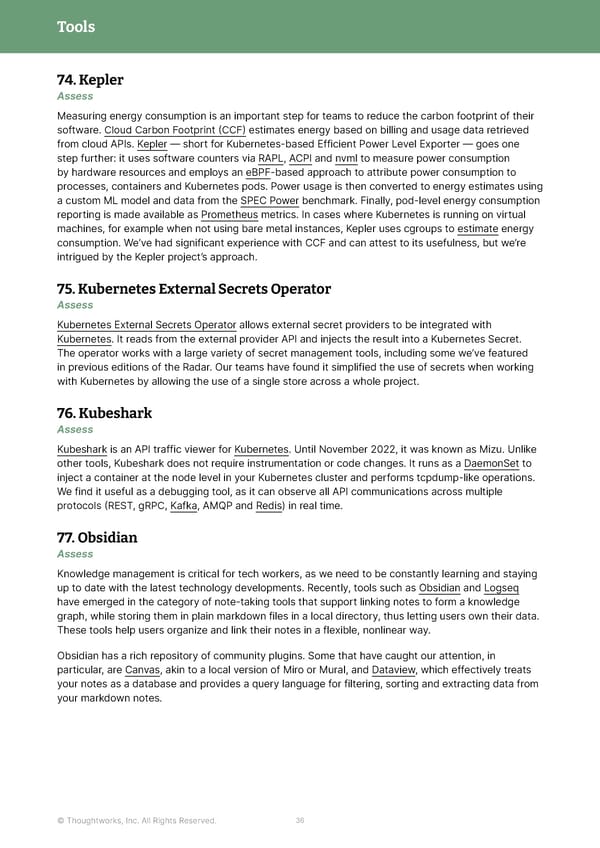Tools 74. Kepler Assess Measuring energy consumption is an important step for teams to reduce the carbon footprint of their software. Cloud Carbon Footprint (CCF) estimates energy based on billing and usage data retrieved from cloud APIs. Kepler — short for Kubernetes-based Efficient Power Level Exporter — goes one step further: it uses software counters via RAPL, ACPI and nvml to measure power consumption by hardware resources and employs an eBPF-based approach to attribute power consumption to processes, containers and Kubernetes pods. Power usage is then converted to energy estimates using a custom ML model and data from the SPEC Power benchmark. Finally, pod-level energy consumption reporting is made available as Prometheus metrics. In cases where Kubernetes is running on virtual machines, for example when not using bare metal instances, Kepler uses cgroups to estimate energy consumption. We’ve had significant experience with CCF and can attest to its usefulness, but we’re intrigued by the Kepler project’s approach. 75. Kubernetes External Secrets Operator Assess Kubernetes External Secrets Operator allows external secret providers to be integrated with Kubernetes. It reads from the external provider API and injects the result into a Kubernetes Secret. The operator works with a large variety of secret management tools, including some we’ve featured in previous editions of the Radar. Our teams have found it simplified the use of secrets when working with Kubernetes by allowing the use of a single store across a whole project. 76. Kubeshark Assess Kubeshark is an API traffic viewer for Kubernetes. Until November 2022, it was known as Mizu. Unlike other tools, Kubeshark does not require instrumentation or code changes. It runs as a DaemonSet to inject a container at the node level in your Kubernetes cluster and performs tcpdump-like operations. We find it useful as a debugging tool, as it can observe all API communications across multiple protocols (REST, gRPC, Kafka, AMQP and Redis) in real time. 77. Obsidian Assess Knowledge management is critical for tech workers, as we need to be constantly learning and staying up to date with the latest technology developments. Recently, tools such as Obsidian and Logseq have emerged in the category of note-taking tools that support linking notes to form a knowledge graph, while storing them in plain markdown files in a local directory, thus letting users own their data. These tools help users organize and link their notes in a flexible, nonlinear way. Obsidian has a rich repository of community plugins. Some that have caught our attention, in particular, are Canvas, akin to a local version of Miro or Mural, and Dataview, which effectively treats your notes as a database and provides a query language for filtering, sorting and extracting data from your markdown notes. © Thoughtworks, Inc. All Rights Reserved. 36
 Immersive Experience — Vol 28 | Thoughtworks Technology Radar Page 35 Page 37
Immersive Experience — Vol 28 | Thoughtworks Technology Radar Page 35 Page 37